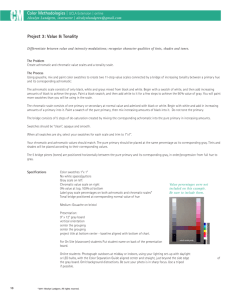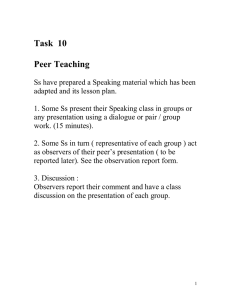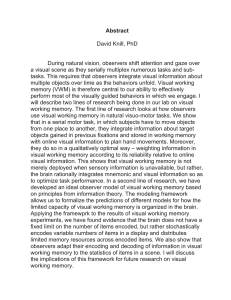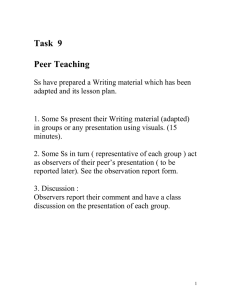Asymmetries in blue-yellow color perception and in the color of
advertisement
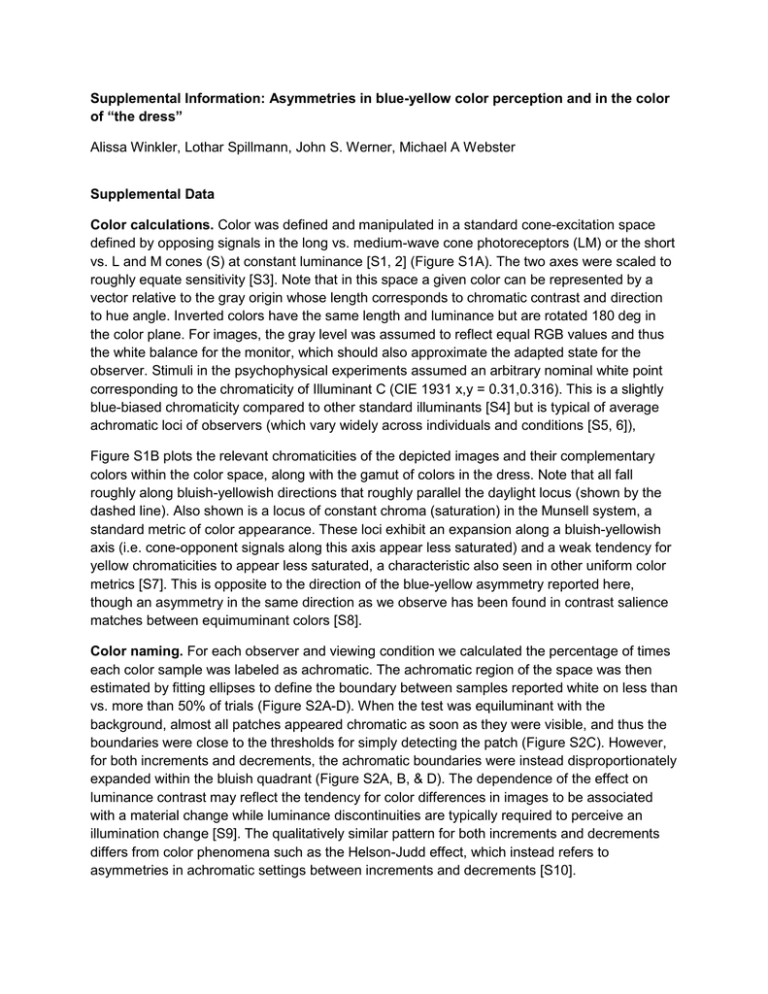
Supplemental Information: Asymmetries in blue-yellow color perception and in the color of “the dress” Alissa Winkler, Lothar Spillmann, John S. Werner, Michael A Webster Supplemental Data Color calculations. Color was defined and manipulated in a standard cone-excitation space defined by opposing signals in the long vs. medium-wave cone photoreceptors (LM) or the short vs. L and M cones (S) at constant luminance [S1, 2] (Figure S1A). The two axes were scaled to roughly equate sensitivity [S3]. Note that in this space a given color can be represented by a vector relative to the gray origin whose length corresponds to chromatic contrast and direction to hue angle. Inverted colors have the same length and luminance but are rotated 180 deg in the color plane. For images, the gray level was assumed to reflect equal RGB values and thus the white balance for the monitor, which should also approximate the adapted state for the observer. Stimuli in the psychophysical experiments assumed an arbitrary nominal white point corresponding to the chromaticity of Illuminant C (CIE 1931 x,y = 0.31,0.316). This is a slightly blue-biased chromaticity compared to other standard illuminants [S4] but is typical of average achromatic loci of observers (which vary widely across individuals and conditions [S5, 6]), Figure S1B plots the relevant chromaticities of the depicted images and their complementary colors within the color space, along with the gamut of colors in the dress. Note that all fall roughly along bluish-yellowish directions that roughly parallel the daylight locus (shown by the dashed line). Also shown is a locus of constant chroma (saturation) in the Munsell system, a standard metric of color appearance. These loci exhibit an expansion along a bluish-yellowish axis (i.e. cone-opponent signals along this axis appear less saturated) and a weak tendency for yellow chromaticities to appear less saturated, a characteristic also seen in other uniform color metrics [S7]. This is opposite to the direction of the blue-yellow asymmetry reported here, though an asymmetry in the same direction as we observe has been found in contrast salience matches between equimuminant colors [S8]. Color naming. For each observer and viewing condition we calculated the percentage of times each color sample was labeled as achromatic. The achromatic region of the space was then estimated by fitting ellipses to define the boundary between samples reported white on less than vs. more than 50% of trials (Figure S2A-D). When the test was equiluminant with the background, almost all patches appeared chromatic as soon as they were visible, and thus the boundaries were close to the thresholds for simply detecting the patch (Figure S2C). However, for both increments and decrements, the achromatic boundaries were instead disproportionately expanded within the bluish quadrant (Figure S2A, B, & D). The dependence of the effect on luminance contrast may reflect the tendency for color differences in images to be associated with a material change while luminance discontinuities are typically required to perceive an illumination change [S9]. The qualitatively similar pattern for both increments and decrements differs from color phenomena such as the Helson-Judd effect, which instead refers to asymmetries in achromatic settings between increments and decrements [S10]. In a second color naming experiment, for each chromatic axis we calculated the proportion of achromatic responses for each contrast level, pooled across 44 observers. These are plotted in Figure S2E-F. The achromatic region for both increments and decrements is restricted to low contrasts along the reddish-greenish axis, extends to higher contrasts along the yellowish axis, and is again substantially broader along the bluish axis, so that equivalent chromatic contrasts along this axis are again more likely to be labeled as white or gray. The proportions remain very similar when instead calculated as the fraction of observers who labeled each stimulus as achromatic at least 50% of the time (not shown). Analyses of the achromatic boundaries based on cumulative normal fits to each individual’s settings showed that the mean boundary (pooled across increments and decrements) for blue (26.8) was 50% larger than for yellow (17.9), a difference that was highly significant (t(87)=4.85, p<.00001), while mean boundaries along the orthogonal axis (10 for 66 deg vs. 11.6 for 246 deg) did not significantly differ (t(87)=1.93, p=.057). The individual boundaries and their slopes varied widely across observers. However, these differences did not predict differences in the reported colors of the dress. Color thresholds. Discrimination thresholds were similarly analyzed by fitting an ellipse to the contrast thresholds for the 8 different hue directions. Mean results are shown in Figure SA-D. The ellipses for both the thresholds and color naming are tilted toward the negative diagonal of the color plane, consistent with a reduced sensitivity to the blue-yellow axis relative to other chromatic directions [S11, 12]. However, with the exception of the equiluminant tests, the thresholds occupy a much smaller region of the color space than the color naming boundaries, and remain relatively more centered on the gray adaptation level of the display. Thus the perceptual achromatic boundaries are not simply a scaled version of chromatic sensitivity, and instead show strong and selective expansion along a bluish axis. Adaptation. Figure S2G illustrates the effects of adapting to different blue-yellow balances. The 5 gray points show the ~blue-yellow (135-315 deg) contrast that matched the afterimage color, as a function of the net contrast bias in the blue-yellow adapting pair. The black star plots the achromatic setting (the “best” white) prior to adapting. In such flickering color stimuli the adaptation depends on sensitivity changes to both the mean color and the contrast, and reflects sensitivity changes in both the retina and the cortex [S13]. Asymmetric responses within these mechanisms should alter the average adaptation state from the color pair, and thus shift the matches away from the stronger color (e.g. shifting the afterimage color toward blue if the yellow component is stronger). Instead the matches fall very close to the prediction if the blue-yellow responses are instead symmetric (i.e. no net afterimage is perceived when the blue and yellow components are an equal distance from gray in the linear color space). Thus these results are again inconsistent with an early nonlinearity (at or before the sites of the adaptation) mediating the perceptual blue-yellow asymmetry. Color naming for the dress. In the initial screening observers were roughly evenly divided in reporting the original dress as white/gold (48.3%) or blue/black (46%), while in the inverted color image 98.9% saw the lighter stripes as a shade of yellow (55.2%), gold (27.6%) or green (16.1%) with none describing them as achromatic. (These yellow vs. green reports are consistent with normal variation in color naming [S3, 14].) In the second session where the range of color contrast was varied, all observers reported the grayscale image as achromatic, and respondents were again roughly evenly split between white/yellow (51%) and blue/black (45%) for the original image. Remarkably, a large fraction continued to report the dress as white/yellow even when the color contrast was increased 2 times (41.3%) or 3 times (28.8%) the original level (Figure S2G, rightmost bars), suggesting they may have continued to attribute the blueness to the illuminant even when the blue in the images was of high contrast. Conversely, reversing the contrast resulted in near-unanimous agreement that the light bars were yellowish, even for contrasts of one half the original. In the color-inverted image the dark stripes were also more likely to be called achromatic, with the percent of blue reports increasing with increasing saturation. Finally, for the 44 additional observers tested with color naming along the blueyellow and orthogonal axis, 36% reported the original dress as white/yellow-gold and 64% blueblack, while 100% responded that the light stripes were yellowish in the color-inverted image. Figure S1. Chromaticities and color manipulations in the images. A) Representation of color in a cone-opponent space with axes corresponding to L vs M or S vs (L+M) cone excitation at constant luminance. Inverting the image color corresponds to rotating the colors by 180 deg around the circle. B) Chromaticities of the image colors and stimuli. Gray: gamut of chromaticities within the dress of Fig 1E; triangles: Fig 1A average chromaticity of the negative (blue) and positive (yellow); star: Fig 1B original (blue) and inverted (yellow) pots; square: Fig 1D and F silver (blue) and inverted (yellow) coins); circles: Figure S1C original (blue) and rotated chromaticities of the text in the Nevada images; dashed line: locus of daylight variations; small connected circles: loci of constant chroma in the Munsell system (chroma = 2; value = 8). C) “Nevada” Images show the effects of rotating an image’s colors by steps of 90 deg, keeping the contrasts constant. In the original image, the letters and prospector (who would presumably be content to see silver or gold) appear white. When the same contrast is shown at the opposite hue angle, the white regions appear tan, while +90 deg rotations appear greenish or purplish. D) Dress images show the effects of altering the contrast while keeping the hue angles constant. Color contrast is varied over +3 times the original image contrast. (Note because of gamut limits some saturated colors are truncated.) Dress image reproduced with permission from Cecilia Bleasdale. Figure S2. Color naming and achromatic settings in the stimuli. A-D) Color naming for stimuli in the LM vs S plane. The lattice of points shows the coordinates of chromaticities sampled. Unfilled symbols were labeled as achromatic on more than 50% of trials. Large ellipses show the boundaries fit to the achromatic settings, based on the mean of 6 observers. Smaller ellipses show the thresholds for discriminating a color change from the gray background chromaticity. Test patches had a constant luminance that was equal (A), greater (B and C) or lower (D) than the background. E-F) Achromatic judgments along a bluish vs. yellowish axis or an orthogonal axis. Points plot the proportion of times (+1 SE) a given contrast was labeled white or gray, for increments (E) or decrements (F), based on settings from 44 observers. G) Adaptation to blue-yellow contrasts with different mean contrasts. Open symbols plot the mean color contrast of the adapting pair (positive = blue biased; negative = yellow biased). Filled symbols plot the contrast of the afterimage color. Star symbol shows the blueyellow contrast chosen as achromatic prior to adaptation. H) Color names selected for the light and dark stripes of the dress, as a function of the scaled color contrast of the dress image (positive = the original dress hues; negative = the inverted hues, as shown in Figure S1). Yellow bars: % observers that labeled the stripes as yellow, gold or green; blue bars: blue; white bars: white or silver; black bars: black or gray. Supplemental Experimental Procedures Apparatus. Stimuli were presented on a SONY Multiscan PS500 CRT monitor controlled by a Cambridge Research Systems Visual Stimulus Generator providing 12-bit resolution per gun. The monitor was calibrated with a PR650 spectroradiometer (Photo Research) and luminances were gamma-corrected. Observers binocularly viewed the display from a distance of 130 cm in an otherwise dark room. Responses were made on a hand held button box. Participants. Observers included authors AW and MW and 49 additional student volunteers who participated in different experiments. All had normal color vision as assessed by standard screening tests and normal or corrected-to-normal acuity. Participation was with informed consent and all procedures followed protocols approved by the University of Nevada Reno’s Institutional Review Board. Procedures. Color naming. This experiment tested the range of chromaticities that were perceived as white or gray. Observers viewed a 2 deg uniform square patch shown on a 11.5 by 15.1 deg uniform gray background. The background luminance was varied from 0 cd/m2 to 10 cd/m2 (thus a background luminance lower than the stimulus patch), 20 cd/m2 (equiluminant with the stimulus patch), and 40 cd/m2 (luminance increment) across separate runs while the test luminance was fixed at 20 cd/m2. In other sessions (not shown)the luminance of the test patch was instead varied relative to a fixed 20 cd/m2 background. Results were comparable between the two paradigms. Observers initially adapted to the background for 5 min and were then shown a series of test patches each displayed for 500 msec with an inter-stimulus interval of 2 sec. The chromaticity of the patch was randomly varied across trials to sample a lattice of points in the chromatic plane (Figure S2). For increments and decrements, 121 stimuli were sampled in equal linear contrast steps from -50 to 50 along the LM and S axes. For the equiluminant condition, a subset of observers were also tested for chromatic variations of equal log steps to more finely sample low contrasts. Observers were shown each chromaticity 6 times in random order, and used a button box to classify the patch as “achromatic” or a specific color from the labels indicated in Figure 2. In other sessions, they instead made a binary classification of “achromatic” vs. “colored.” Settings from either procedure yielded similar achromatic boundaries. In a second set of conditions, a similar procedure was used to probe color naming for stimuli restricted to a bluish-yellowish (156-336 deg) axis or the orthogonal (66-246 deg) axis within the space. This axis was chosen to roughly coincide with the axis of the image chromaticities and the dress gamut, and are shown as cross hairs in Figure S1B. Only two background levels were tested (0 and 40 cd/m^2). Settings were collected for 44 observers to examine individual differences in the achromatic boundaries. Discrimination thresholds. This experiment examined how sensitive observers were to detecting a color change away from the nominal gray point. To measure the thresholds, the test patch was divided into 4 quadrants. Three were maintained at the nominal gray level while the 4th was randomly chosen to display a chromatic step. Observers made a 4-alternative forced choice response to indicate the test quadrant, with the test contrast varied in a staircase to estimate the detection threshold. The hue angle of the test was varied along 8 randomly interleaved directions corresponding to steps of 45 deg around the color plane. Thresholds were based on the mean of 4 repeated staircases for each hue angle at each of the same 4 background luminances used in the color naming task. Chromatic adaptation. This experiment tested for suprathreshold nonlinearities in the contrast response to the blue-yellow axis, by adapting to a patch that alternated between blue and yellow. For example, a compressive (e.g. log) response in the S cones predicts that linear increments (+S for blue) should be weaker than decrements (-S for yellow), and thus the yellow component should dominate the time-averaged adaptation state (so that the net effect of the pair is equivalent to adapting to a weak yellow, and thus should produce a blue aftereffect) [S13]. To test this, we measured aftereffects for different balances of alternated blue and yellow contrasts (i.e. 60:20, 50:30, 40:40, 30:50, and 20:60) in a random order across separate runs. Observers initially adapted for 1 min to the alternating color patches shown in a 2 deg “adapt” field above fixation and on a black monitor background.. The colors were shown for 500 msec each and were separated by 250 msec black intervals to avoid successive contrast effects. During adaptation a 2 deg gray “matching” field below fixation was presented whenever a color patch was presented above fixation. On test trials, the upper adapting field displayed a zero contrast (gray) test for 1 sec, and observers adjusted the blue-yellow contrast of the lower field until it matched the afterimage color in the adapting field. Test trials were interleaved with 6 sec of readaptation until the observer made 6 match settings. All stimuli were confined to a blueyellow axis of 135-315 deg in the color plane, with the relative contrast of the blue and yellow adapting components varied across runs to estimate the relative balance at which they were equivalent to gray adaptation. Color naming in the dress. Two surveys were performed during an undergraduate class. Students viewed the original image of the dress or a color-reversed image, and recorded the dress colors they perceived for the light and dark stripes. The images were shown on a screen illuminated by an overhead projector and were viewed simultaneously under normal lighting by students seated in the class. 87 students were tested in one session with the original and inverted image. In a second session with 80 students, the survey was repeated with images varied in contrast relative to the original, over a range from +3 (original hues) to -3 (inverted hues) in steps of 0.5 (Figure 1). For each image observers reported the color of the light or dark stripes using the 11 basic color terms [S15] plus silver and gold as response options. Supplemental References S1. S2. S3. S4. S5. S6. S7. S8. S9. S10. S11. S12. S13. S14. S15. MacLeod, D.I., and Boynton, R.M. (1979). Chromaticity diagram showing cone excitation by stimuli of equal luminance. Journal of the Optical Society of America 69, 1183-1186. Derrington, A.M., Krauskopf, J., and Lennie, P. (1984). Chromatic mechanisms in lateral geniculate nucleus of macaque. Journal of Physiology 357, 241-265. Webster, M.A., Miyahara, E., Malkoc, G., and Raker, V.E. (2000). Variations in normal color vision. II. Unique hues. Journal of the Optical Society of America. A, Optics, image science, and vision 17, 1545-1555. Wyszecki, G., and Stiles, W.S. (1982). Color Science, 2nd Edition Edition, (New Yord: John Wiley). Chauhan, T., Perales, E., Xiao, K., Hird, E., Karatzas, D., and Wuerger, S. (2014). The achromatic locus: effect of navigation direction in color space. Journal of vision 14:1:25, 1-11. Werner, J.S., and Schefrin, B.E. (1993). Loci of achromatic points throughout the life span. Journal of the Optical Society of America A 10, 1509-1516. McDermott, K.C., and Webster, M.A. (2012). Uniform color spaces and natural image statistics. Journal of the Optical Society of America. A, Optics, image science, and vision 29, A182-187. Switkes, E. (2008). Contrast salience across three-dimensional chromoluminance space. Vision research 48, 1812-1819. Kingdom, F.A. (2008). Perceiving light versus material. Vision research 48, 2090-2105. Chichilnisky, E.J., and Wandell, B.A. (1996). Seeing gray through the ON and OFF pathways. Visual neuroscience 13, 591-596. Nagy, A.L., Eskew, R.T., Jr., and Boynton, R.M. (1987). Analysis of color-matching ellipses in a cone-excitation space. Journal of the Optical Society of America. A, Optics and image science 4, 756-768. Danilova, M.V., and Mollon, J.D. (2011). Parafoveal color discrimination: a chromaticity locus of enhanced discrimination. Journal of vision 10. Webster, M.A., and Wilson, J.A. (2000). Interactions between chromatic adaptation and contrast adaptation in color appearance. Vision research 40, 3801-3816. Malkoc, G., Kay, P., and Webster, M.A. (2005). Variations in normal color vision. IV. Binary hues and hue scaling. Journal of the Optical Society of America. A, Optics, image science, and vision 22, 2154-2168. Berlin, B., and Kay, P. (1969). Basic color terms: Their universality and evolution., (Berkeley: University of California Press).

